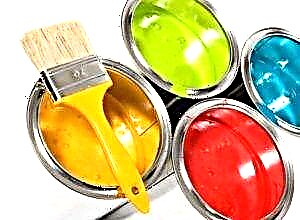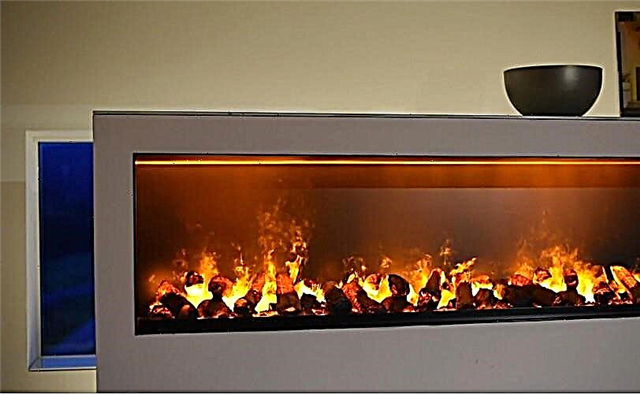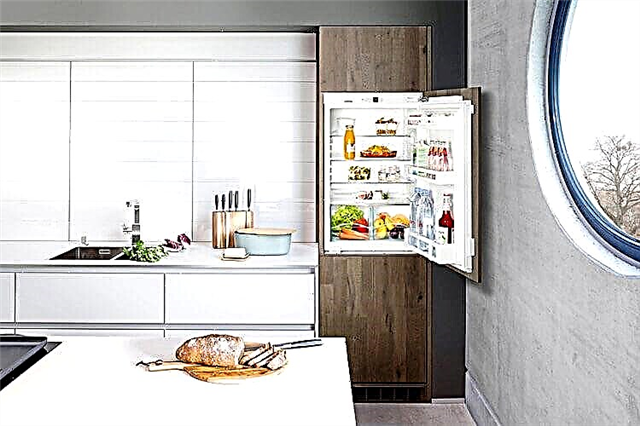
In a new or overhaul building, as a rule, you have to decide on the arrangement of floors and the choice of screed. The screed is an intermediate layer between the base of the floor and the floor covering, it compensates for irregularities, provides heat and sound insulation, masks engineering communications.
The screed is made from various building mixtures, carefully leveling and smoothing them. It is important that there are no voids and cracks in the screed; the floor service life depends on this.
How to choose a screed for the floor
The screed for the floor can be dry, semi-dry or wet, depending on the percentage of water in the mortar used. Choose the type of screed, taking into account the following factors:
- Availability of equipment for installation.
- Base load.
- Speed and complexity of laying.
- The time required for shrinkage and drying.
- The cost of materials and work.
To install the screed, you will need to clean the base and close the cracks in it, lay the waterproofing. In the case of wet and semi-dry screeds, in order to ease the load on the floor slab, a layer of expanded clay is often poured before pouring. To obtain a horizontal surface, “beacons” are used - special guides by which they determine the desired level of the working mixture and level it, removing excess and smoothing.
To better understand what type of floor screed to choose, let's look at their main characteristics.
Wet floor screed
A wet screed is called pouring the prepared base with a cement mixture, most often with cement-sand mortar (sand concrete). Sand concrete is the most versatile material, it is used in large-scale capital construction.
Advantages of wet screed:
- The cheapest material for arranging screeds.
- Low cost.
- It can be used to create a finishing surface in technical rooms.
- Suitable for rooms with high humidity.
- High grade strength M150.
Disadvantages of wet screed:
- Reinforcing mesh required.
- Shrinkage takes 28-30 days, there is a chance of cracking.
- Screed moisture control during shrinkage required.
- It is quite difficult and long to prepare the solution yourself, as well as level the surface.
- Heavy weight, high load on the floor.
- It is necessary to use self-leveling mixtures (bulk floor) after laying the screed.
- The need for floor insulation.
The wet screed mix can be made at the factory or directly at the construction site using a concrete mixer. It should be borne in mind that for each room there is only one day for the installation of screed. In this case, there will be no seams and, as a consequence, no cracks.
Dry floor screed
This screed consists of light bulk material (expanded clay, perlite, vermiculite), on top of which sheets of drywall, chipboard or plywood are placed on metal profiles in one or two layers. Joints of sheets are glued.
Benefits:
- Simple, quick and clean installation available to home craftsmen.
- The mixture is immediately ready for use.
- It does not require expensive professional equipment.
- Provides high sound insulation.
- It does not require drying and shrinkage.
- Due to the lack of water in the composition of the working mixture, it can be easily mounted in the cold season, as it is not subject to freezing.
Disadvantages:
- Formation of mold under the floor with the slightest leakage of water.
- Not suitable for unheated and humid rooms, basement floors and basements.
- The cost is 2–2.5 times higher than that of a wet screed.
Professional builders often say that in addition to moisture, the main enemy of dry screed is laymen. If the backfill is poorly tamped, it shrinks and the top sheets are held on the profiles. This leads to floor deformation. Sheets must be held over their entire area so that the load is evenly distributed. The profiles themselves must be smooth, otherwise the floor will be with differences in height. Although professionals can remake a dry screed in one day, this is an additional cost. Therefore, if you decide to make a dry screed, immediately discard the idea of saving on the call of the construction team.
Semi-dry floor screed
Combines the benefits of wet and dry screed. Working material - wet friable cement-sand mixture with plasticizers and additives. Mobile mortar pumps (pneumosuperchargers) are used for kneading and feeding into the room. The finished surface is treated with a grinder. In order to prevent the semi-dry screed from cracking, immediately after grouting the surface, the so-called shrink joints are cut to a depth of 1/3 of the thickness of the screed. They should be smooth and without branches. Before laying the topcoat, they are sealed with sealant. With increased mechanical load on the screed, the seams can be reinforced with metal corners.
You can walk on such a screed 12 hours after installation. She is also ready to lay the flooring earlier than wet:
- tile - after 72 hours,
- linoleum - in 12-14 days,
- carpet - after 14-20 days,
- parquet, laminate - in 20–25 days.
In industrial premises, as a finish, a semi-dry screed can be impregnated with special reinforcing solutions or filled with the so-called bulk floor.
Advantages of semi-dry screed:
- Quickly sets, gives slight shrinkage, is not prone to cracking.
- Instead of reinforcing mesh, fiber is used, which is already part of the mixture.
- Universal, suitable for use in residential and industrial construction.
- Does not create a large load on the floor.
- Has high brand strength.
Disadvantages:
- Installation requires special equipment and a professional team.
Turnkey cost - low, like a wet screed.
To summarize
For clarity, we have reduced the data for different screeds into a small table.
Table 1. Characteristics of different types of screeds
| Characteristic | Type of screed | ||
|---|---|---|---|
| Dry | Wet | Semi dry | |
| Drying and shrinkage | Not required | 28-30 days | 1-2 hours |
| Cracking | — | maybe | Hardly ever |
| Minimum allowable room temperature | Any | Not lower than + 5 ° С | Not lower than + 5 ° С |
| Possibility of walking | Immediately after mounting the protective sheets | 72 hours after installation | 12 hours after installation |
| Laying flooring | The day after installation, when the glue dries | 28-30 days after installation | 3–25 days after installation |
| Paving area per day by one team (max.) | 100 sq.m | 50 sq.m | 250 sq.m |
| Cost | From 1000 rubles / sq.m, not counting work | From 450 rubles / sq.m turnkey | From 450 rubles / sq.m turnkey |
The cost of the screed can vary depending on such parameters as the total installation area, screed thickness, number of storeys and location of the object, the need for reinforcement with a metal mesh, individual characteristics of the object. In the cold season, wet and semi-dry screed may require additional measures against freezing the mixture, which will also increase the cost of work. Also, do not forget about additional work that may be required: delivery and unloading of materials, lifting to the desired floor, dismantling the old screed, and garbage collection.
So, the best option for the ratio of price, time and quality at the moment is a semi-dry screed. Dry screed can be advised for repairs in small apartments. In large-scale construction, when there is a large margin of time before the start of operation of the house, the price parameter is important, and mortar can be purchased in large batches at the factory, wet screed is the main option for arranging floors. For the overhaul of residential and public buildings, the construction of private houses, the arrangement of apartments in new buildings, the answer to the question of which screed is better is unequivocal - semi-dry.
The composition of the mortar for floor screed: DSP or concrete with gravel
The floor screed is most often made from a cement-sand mixture. That is, the solution contains only cement and sand, sometimes with additional additives. In the classic version, the screed is poured only by mixing sand and cement in a certain proportion, the mixture is diluted with water. Such a solution is also called sand concrete. In the sense that only sand is used as a filler. This is the cheapest option, but not the only one.
With a screed thickness of more than 5 cm, concrete with aggregate made of fine gravel can be used. Classic concrete: some crushed stone is added to the sand and cement. Its dimensions are not more than half the thickness of the screed. Since the minimum size of crushed stone is 20-25 mm, the minimum thickness of the concrete screed is 50 mm.
Which floor screed is best to use? 
But concrete with gravel is heavier and more expensive. Its advantage is that it is less prone to cracking during shrinkage and therefore concrete floors are poured with warm floors. Here, a small number of cracks is critical. For a regular leveling screed, the presence of shrinkage cracks is not such a problem. The budget is usually limited and therefore it is more often the cement-sand mixture chosen.
Sometimes gypsum-based compounds are used for screed. But they are afraid of moisture, the solution has a shorter lifespan, the surface strength is lower. All this makes them unpopular. A gypsum-based screed solution in recent years is a rarity.
Brand of cement-sand mortar for screed: the choice of strength
What brand of cement-sand mortar is used for screed? Previously, they could put M50 or M75. Now minimum - M150. Why? Because, first of all, the requirements for decoration were much lower. What used to be considered normal - small pits, cavities, cracks - is now unacceptable. And this is not only aesthetics. To a greater extent, these are the requirements of manufacturers of finishing coatings. They require an almost perfect surface that does not dust, and only a solution with a strength of at least M100 can give such a surface.
The brand of cement-sand mortar for screed is selected based on the laid flooring 
There are other reasons why the grade of the solution is used higher. First one. Nobody is sure of the quality of cement, so they prefer to play it safe than redo it. The second - modern coatings require an even, solid base and the mortar for the screed must be strong. And the third - you can’t just put a low grade under self-leveling compounds or under modern tile adhesive with polymer additives. So that the two parts of the coating do not separate, the difference in strength should be no more than 50 units. That is, if the leveling mixture has a strength of M250, the mortar for screed must be strength M200 and not lower. The same with tile adhesive. So pay attention to this.
Proportions of classic DSP screed
The classic solution for screed, as already mentioned, is cement with sand, diluted with water. The proportion (amount of sand per unit of cement) depends on the required strength of the screed and the brand of cement used. To ensure that the floor surface is durable, use expensive Portland cement grade M400 and higher.
Proportions of mortar for floor screed for M150, M200 and M300 when using cement of different grades 
For floor screed in the utility rooms, you can use the cheaper M300. It will go a little more, but there will be savings. For the foundation in a house or apartment under modern coatings, it is better not to take such cement. Remaking will require significantly more savings on cement.
For beginners in the construction business, it seems that if you take more cement, there will be a stronger screed. But no. For strength, the correct ratio of all components is important, and an excessive amount of cement can cause a decrease in strength. If you want a stronger screed - use high-quality cement and accurately measure the proportions. Water, by the way, is not worth taking anymore either. This will increase the fluidity of the solution, but will increase the number of shrinkage cracks. So again: to get strong and reliable concrete, proportions must be strictly observed.
Which sand to take
Sand is better to take river, and - washed, at least two fractions: large and medium. Why river? Because it has sharp edges, and this reduces the likelihood that it will settle in the lower layers. This is understandable. Why washed? It has a minimum of dust. The less dust, the higher the strength of the solution. Sand also needs a different size so that the strength of the solution is normal.
For floor screed you need sand: washed river, two fractions (not fine) 
If you are going to lay an expensive coating with high requirements on the strength of the base (parquet, parquet or engineering board, vinyl tile), it is better to take just such sand. There will be less problems.
Kneading sequence
When making a solution for screed, dry components are first mixed - cement and sand. With manual kneading (in the trough), what to cast in the first place - cement or sand, there is not much difference. If you use a concrete mixer, immediately throw sand and twist it for a couple of minutes without cement. Then, gradually, usually shovels add cement. After each serving, wait until it is more or less evenly distributed, then throw the next one. After adding the entire amount of binder, mix until a uniformly colored mixture is obtained.
You choose how to prepare the solution yourself: order at the factory / workshop, knead yourself 
When the dry components are mixed until a homogeneous gray mass is obtained, little by little water is introduced. It is counted from the amount of cement. Usually, 0.45-0.55 parts of water are taken per 1 part of cement. Why do not indicate exactly? Because the amount of water depends on the humidity of the sand. And it is advisable to pour a minimum of water: this way there will be fewer cracks when dried.
Ready mortar or sand cement mixture
Those who at least once independently mixed CPS or concrete are more likely to buy ready-made concrete. And not a mixture of sand and cement in bags, namely concrete from a concrete mixer. Yes, it’s more expensive for money, but it takes much less time and effort. Another plus of this solution: pouring without cold seams. And that means less cracks and problems later on. The next plus - concrete mixers can deliver the mortar to the desired floor. Imagine that you need to drag a couple of tons of sand and cement. Even if there is a freight elevator, it is not easy. It can be costly if you pay utility workers. Climbing stairs “on shoulders” is generally a problem.
So that you do not care about the proportions of cement and sand, you can buy the finished mixture in bags 
What are the advantages of buying a ready-mixed sand-cement mixture in bags? In that the proportion is precisely maintained, the sand was used in several fractions and in the right quantities. That is, the screed is guaranteed to have the right strength. Minus is the price. You can buy the same amount of cement and sand for a much smaller amount. This is if you do not bother with fractions of sand. If we take care of this, then the savings will become less: not all fractions are cheap.
Additives: needed or not?
Plasticizers and fiberglass or other substances for micro reinforcing may be recommended to add to a classic mortar for floor screed. Are they needed or not? First you need to understand what it is and why.
Making mortar for screed can do only sand and cement 
Plasticizing Additives
Plasticizers - substances that increase the ductility of the central joint site.Working with such solutions is easier. Concrete with a plasticizer is better laid, easier to level, gives a smoother surface. In general, if all components of normal quality are well mixed, then it is not difficult to work with closed water with them. With additives, of course, is easier. But factory plasticizers cost a lot of money, and this increases the cost of screed. You need to add them in small quantities, but the bill when filling the floor in the house goes to cubic meters, so that the costs will be tangible.
When mixing the proportions of the solution must be observed with great accuracy. To make the solution fit better, add plasticizers, not more water 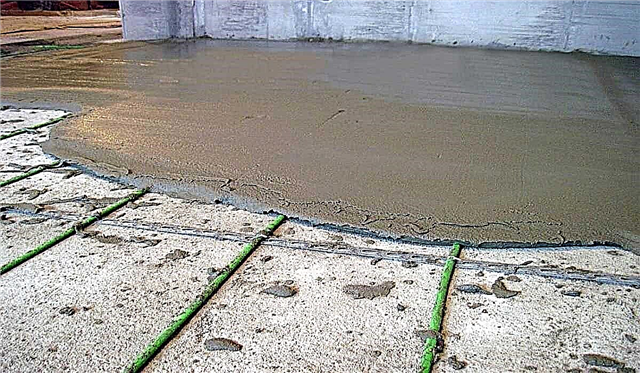
As usual, the craftsmen found a replacement for factory plasticizers. Normal soap is added to the solution. Its consumption is very small - a glass or so on one concrete mixer. The plasticity of the solution increases, so many use this type of additive. For beginners, it is worth saying: do not exceed the recommended dose. The solution will not get better, but it could well be worse. Soap increases ductility, “lubricating” sand, reducing its “adhesion” to cement slurry. Exceeding the dosage can lead to a decrease in the strength of the screed. So be precise.
Micro reinforcement
As you know, when dried, the cement-sand mortar shrinks. The amount of shrinkage is from 1.5% to 3% of the volume. Specifically, the percentage of shrinkage depends on the amount of impurities (if the sand is washed, the shrinkage will be less), the correct composition of the aggregate (in this case, sand), the exact proportions and a number of conditions and factors.
It looks like polypropylene fiber 
Everything would be fine, but with shrinkage, cracks form in the solution. They are always there, only larger or smaller, in larger or smaller numbers. To reduce the number of cracks, microreinforcement materials are added to the solution. Most often, fiber is used in everyday life. It happens:
- fiberglass
- basalt
- metal
- polypropylene.
The most popular for household purposes is polypropylene fiber. It is the most inexpensive and gives a good result. How does it work? 100 grams of this supplement contains a huge amount of synthetic fibers. They are very thin, but synthetics are highly durable. These fibers are randomly but evenly distributed throughout the thickness of the solution. In concrete, they form in space a kind of lattice. When stress occurs when the screed dries, they bind the parts of the solution together, reducing the number and size of cracks.
It’s important to comply with supplementation 
The second effect of fiber is a smoother and more durable surface. So this additive to the floor screed is more useful and definitely worth using. But again, strictly according to the recommendations. It seems that if you add more fiber, then there will be fewer cracks, but no. The strength of the screed will decrease.
Screed solution volume calculation
To determine the volume of materials, you need to know how much solution is needed. Then, using the necessary proportions for the screed, it will be possible to calculate the approximate amount of sand and cement. To carry out the calculation of the solution, you need to know the area over which we will fill the solution and the thickness of the layer.
The fill area is simple to calculate: the length of the room in meters is multiplied by its width. We get the area. You should already know the maximum and minimum screed layer. By the degree of evenness of the base, approximately average thickness can be determined. If the found area is multiplied by the thickness of the screed and we get the required volume of solution.
Another table with the proportions of the mortar for floor screed 
Let's look at an example. The room is 2.8 m by 3.4 m, the screed thickness is 6 cm. We find the pouring area - 2.8 * 3.4 = 9.52 m². To get cubic meters of concrete, which we need, we need 6 cm to translate into meters. To do this, divide 6 cm by 100. We get 0.06 m. Now we multiply the pouring area by this figure: 9.52 * 0.06 = 0.5712 m3. That is, for a room area of 9.5 squares with a screed thickness of 6 cm, approximately 0.6 cubic meters of solution will be required. With such a volume, the solution for floor screed will definitely have to be kneaded on its own. No concrete plant will deliver less than a cubic meter of mortar.
If you need to fill the screed in several rooms at once, you can first calculate the area of all rooms for pouring, then multiply by the thickness of the screed. This option is possible if there are no large differences in height between different rooms. If in one room the screed is 6 cm, in the other 9 cm, it is better to consider the volume for each room separately, and then add the results.
Screed cement consumption
If you decide to knead the mortar for the screed on your own, you need to determine the amount of cement that you need. It can be calculated based on the solution volume found. There are tables that show the consumption of cement for screed, depending on the brand of mortar and binder.
The amount of cement in one cubic meter of screed 
We calculate the amount of cement for one cube of screed made of sand concrete of the M150 brand. If we use cement M400, 400 kilograms of cement (according to the table) will go to a cube. To find how much cement will be needed for the example described above, you need to multiply the solution volume found by the norm: 0.6 m³ * 400 kg = 240 kg. That is, 240 kilograms of cement will be needed for this room. To determine the number of bags, divide this figure by the mass of cement in the bag.
- If the bag has 50 kg of cement, you will need: 240 kg / 50 kg = 4.8 bags.
- When packing 25 kg: 240 kg / 25 kg = 9.6 bags.
Another packaging also happens, but is rare. When you decide on the brand and manufacturer, it will be possible to accurately calculate the number of cement bags per floor screed.
How to calculate the amount of cement per cubic meter of sand 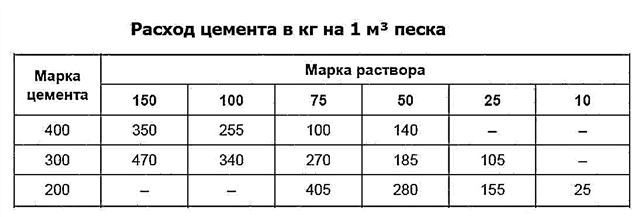
Another cement consumption can be calculated based on the amount of sand available. You never know. Maybe someone will buy sand and so that there are no leftovers, it must be used up.
Cement-sand mixtures
The most popular option, which has good qualities, is excellent for leveling the concrete base in apartments and private houses. It can also be used for coating in bathrooms and showers, as it is moisture resistant. The preparation of the solution consists in mixing a certain amount of cement and sand, if necessary, special additives are used to enhance the properties.
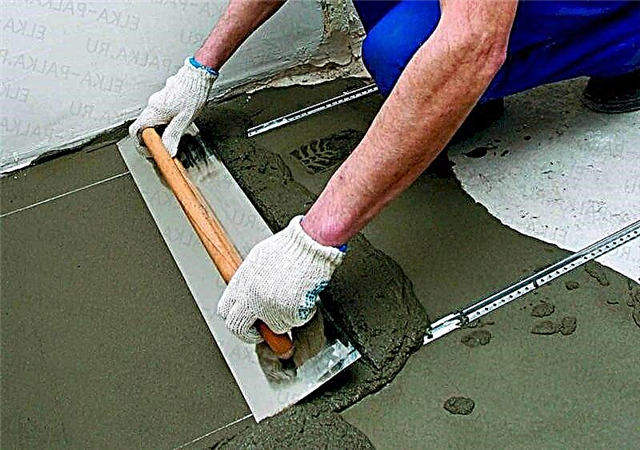 Only a professional can prepare a cement-sand mixture with minimal shrinkage
Only a professional can prepare a cement-sand mixture with minimal shrinkage
Pouring properly prepared material is fairly easy with the help of beacons. It should be borne in mind that the cement-sand screed also has drawbacks, the main of which is considered to be large shrinkage, sometimes up to half of the surface being poured. To ensure reliability, reinforcement is required.
Concrete Compounds
They differ from the previous version in lower cement content. To obtain a specific brand of concrete, special schemes for mixing dry components are used. Prepared mortar is suitable for roughing. Although it does not shrink severely, it is very susceptible to moisture. Due to its lower density, it is suitable for working on different floors.
 Classical concrete, where crushed stone acts as a filler, refers to strong rough screeds
Classical concrete, where crushed stone acts as a filler, refers to strong rough screeds
Gypsum-based mixtures
They differ from the DSP in that they require less time for complete drying. Allows to level a surface in the room with steady humidity. Due to the fact that such a solution does not shrink, it is used to fill thin layers of screed.
 The gypsum screed hardens quickly, so it requires professional application
The gypsum screed hardens quickly, so it requires professional application
Self-preparation of the solution
A mixture for leveling the floor on the basis of dry components can be prepared exclusively with your own hands. Due to the fact that the cement-sand variety is considered the best solution for leveling the concrete floor, it is precisely its preparation that should be given special attention.
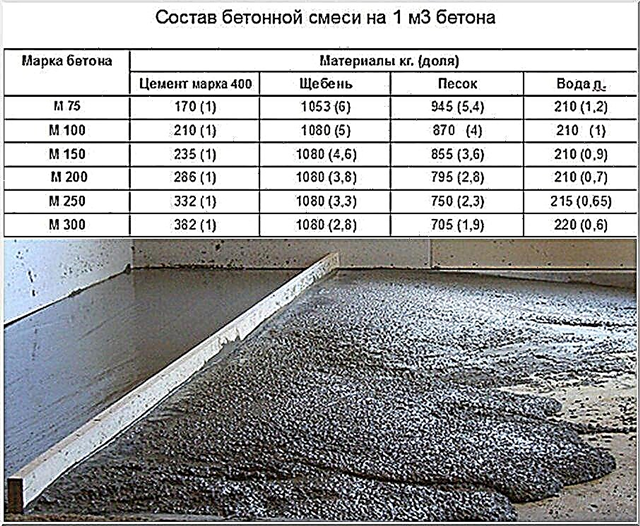 It is believed that for domestic premises the best option would be concrete grade M200
It is believed that for domestic premises the best option would be concrete grade M200
So, the work is performed according to the scheme:
- Dry components are prepared: carefully sifted sand and cement of the desired grade. Additionally, plasticizer and fiber are purchased, if it is necessary to make reinforcement. The exact ratio of the proportions of the substances used is the key to successful work.
- The calculation of the required number of components is carried out as follows: for one part of cement of the M400 brand, 4 parts of sand are needed. The components are mixed until a homogeneous mass, if necessary, additives are used in the form of a dry substance. Only after this stage does final mixing take place. For example, to obtain a concrete mix corresponding to the M100 brand, 4.6 parts of sand and 7 parts of crushed stone are added to one part of cement (M400).
- Water with mixed liquid additives is poured into the prepared container and the resulting mixture is poured. To obtain a homogeneous solution, an electric mixer or a nozzle on a drill is used.
Ready-made screeds
At present, do-it-yourself mixes for floor leveling, which are sold ready-made, are becoming increasingly popular. It is enough to mix them with the right amount of water and you can fill the screed. This greatly simplifies the process and distinguishes these materials from traditional options.
Advantages of finished compounds
Now an increasing number of specialists and home masters prefer to use dry mixes for screeding. This solution seems to be the most attractive because of the undeniable advantages of these compounds:
- Ease of preparation. Indeed, the finished product does not need a long and accurate selection of all components. This is a very significant advantage, since it is the correct combination of proportions that gives the solution the necessary properties.
- The consumption of dry mix per 1 m 2 screed is much less. This is due to the accuracy of the dosages necessary to improve the performance of complex additives. An important factor is the lower weight, which leads to a weakening of the pressure on the floor.
- The solution is mixed by using an electric drill and mixer nozzle, which allows the process to be carried out at home even when working in small rooms. To prepare a concrete composition, for example, you need to use a concrete mixer.
 The finishing liquid screed has not only high quality, but also a luxurious appearance
The finishing liquid screed has not only high quality, but also a luxurious appearance
Ready mix for floor screed allows you to achieve optimal results with minimal labor.
Cement-based bulk solutions
Although this category contains cement, it differs significantly from the traditional version. The differences are in the addition of mineral and synthetic fillers and special modifiers. Such formulations are divided into subspecies that differ in how they are used:
- Products for roughing. This material contains a sandy mixture of coarse fractions and granite chips. Many masters consider this solution optimal for pouring coatings under a warm floor with a resulting thickness of 30 to 80 mm. It must be borne in mind that the finished structure needs additional alignment.
- Bulk mixes for finishing the floor. They include a finer fraction of sand and special plasticizers. The resulting surface has perfect smoothness and is completely ready for subsequent cladding. This option is perfect for creating a minimum thickness of 4-5 mm. To increase reliability, fiber or fiberglass reinforcing mesh is used.
- Self-leveling compounds. This material contains a fine fraction of substances, it is suitable exclusively for creating a finishing coating with a thickness of 3-5 mm. Drying requires a minimum amount of time, but the products are quite expensive.
- With a special mixture for pouring underfloor heating. Of course, other options can be used for this, but only such a solution helps to get the best result. It's all about increased ductility, which is achieved only due to correctly selected components.
 Despite the large assortment, there are 2 directions of dry solutions - these are self-leveling mixtures and levelers, which require arrangement
Despite the large assortment, there are 2 directions of dry solutions - these are self-leveling mixtures and levelers, which require arrangementPlaster-based formulations
An additional component is sand and fibers to provide the desired strength. Such a dry mix for screed is suitable for rooms with stable humidity. Distinctive features are environmental friendliness and good heat-insulating qualities. Suitable for creating surfaces on wooden floors.
Which floor mix is best?
It is rather difficult to answer this question unequivocally, each option is suitable for a specific situation. So, the first layer of screed is perfectly created using traditional compositions and bulk solutions for roughing. For finishing events with a slight curvature of the base, it is better to use a self-leveling view.
Calculation of dry mixes for work
In order to determine how much dry mix is needed for screed per 1 m2, simple steps are performed:
- The room area is measured, the required layer thickness is immediately determined. The obtained indicators in meters are multiplied.
- The result is divided by 0.1 and multiplied by the flow rate of the selected mixture. These data are indicated by the manufacturer on the package per 1 m2 with a thickness of 10 mm.
- 5% is added to this number.
For example, the total area of the room is 20 m2, the required thickness is 30 mm, i.e. 0.03 m.
The consumption of the composition per 1 m2 with a thickness of 10 mm will be 15 kg.
That is, packages weighing 25 kg will need 4 pieces.
 The consumption of the composition indicated on the package is derived under reference conditions, in reality, from 5 to 7% is added to this value
The consumption of the composition indicated on the package is derived under reference conditions, in reality, from 5 to 7% is added to this value
Ready-mixed screed
Preparation and pouring of dry leveling compounds is almost identical to traditional concrete and cement options. For work you will need similar tools.
 The high price of building mixtures is more than offset by the exceptional quality and ease of arrangement
The high price of building mixtures is more than offset by the exceptional quality and ease of arrangement
- The base is being prepared.
- Set to zero.
- The solution is mixed. To do this, dry matter is added to the water.
- Filling is quick, otherwise the composition will lose its properties.
- For alignment, beacons and a suitable tool are used.
- Drying time depends on the variety selected.
Thus, an even and reliable coating is obtained, perfectly suitable for laying tiles, carpet or laminate.
General information about the composition of the mortar for screed
The process of preparing mortar for screed
The process of preparing the mortar for screed is reduced to thoroughly mixing certain components in the prescribed proportions.The most versatile and often used are cement-based mixtures: they are not afraid of moisture, which allows pouring such solutions in any room.
The main disadvantage of cement mortars is the tendency to shrink, which is quite large. Therefore, if the solution is poorly mixed and laid in a thin layer, the surface will most likely become covered with cracks. In order to prevent cracking, the screed is made using reinforcing mesh. In addition, special reinforcing components can be included in the composition of the solution.
The actual composition of the cement screed for the floor is given in the following table.
Table. The composition of the mortar for floor screed
| Component | Functions |
|---|---|
| Cement | It is the basis of the composition for floor screed. It is responsible for strength and other significant operational characteristics of the fill. |
| Sand | As a rule, carefully washed construction sand is used. Functions as a fine aggregate. Using river sand is strictly not recommended - the screed will be of extremely low quality. |
| Polypropylene fiber | Using this component allows you to maximize the quality of the screed. The material helps to reduce the severity of the main disadvantage of cement compositions - plastic shrinkage. In addition, fiber helps increase the strength and durability of the screed. Professional builders strongly recommend the use of polypropylene fiber for screeds. Although this will lead to some increase in the cost of work, on the other hand, the surface with almost 100% probability will not be covered with cracks. |
| Plasticizer | It helps to increase the plasticity of the finished mixture, which makes it possible to lay the screed with less water and increases the available application time of the mixture on average up to 8-12 hours. |
| Water |
When choosing the proportions of the mortar for the screed, it is necessary to take into account the features of the operation of the room in which the finishing work will be performed. For example, if the floor will be subjected to intense loads and strong mechanical stresses, it is recommended to take 1 share of cement and 3 shares of sand to prepare the solution. With this ratio, the screed will be strong and reliable enough.
The proportions of the solution depend on the purpose of the room
In general, the composition of the mixture can be adjusted by reducing or increasing the proportion of one or another component. But it is important to know that with a decrease in the sand content, the strength of the screed will also decrease - such a coating will quickly become covered with cracks, lose its performance and collapse.
Screed may crack if there is too little or too much sand in the mixture
For residential buildings with low and medium loads, mortars consisting of 1 part of cement and 4 parts of sand are usually used. The number of other components is selected in a practical way until a mixture of normal working density is obtained or in accordance with the recommendations of the manufacturers. A similar composition allows you to get a fairly high-quality mortar for laying screeds. At the same time, adding too much sand to the mixture is also impossible, because because of this, the strength characteristics of the coating will be violated and the filling will quickly collapse.
As for the reinforcing fiber, it is added in an amount of about 0.6-0.9 kg per 1 m3 of the finished solution. The required proportion of plasticizer should be specified individually - manufacturers provide this information in the instructions for their products. Water, if you adhere to the proportions of other components, you will need to add in an amount of about 15 liters for every 50 kg of cement.
FIBRAR polypropylene fiber
Plasticizer for concrete Plitonite
In addition to cement screeds, special gypsum mortars are often used. As a rule, they are used to eliminate small irregularities in conditions when there is no time to wait for the cement screed to completely harden. Anhydride mixtures can be laid in a thin layer, and they dry on average in 1-3 days, which greatly facilitates and speeds up the work process. The only limitation: gypsum screeds are not suitable for use in rooms with high humidity.
If desired, both cement and gypsum compositions can be purchased ready-made, with all the necessary plasticizers and other additives. Often, manufacturers introduce special modifiers into their mixes that improve various properties of the screed, for example, increase its fluidity and facilitate the laying process. However, under any circumstances, you will have to spend more money on the purchase of the finished mixture than on the purchase of the initial components separately and the independent preparation of the solution.
Concrete additives
The choice of proportions depending on the brand of feedstock and the finished composition
Determining the optimal composition of the mortar for the screed, it is necessary, first of all, to focus on the indicator of the grade of cement, as well as the necessary brand of the finished solution - the higher the last indicator, the stronger and more durable the screed. Information regarding these points is provided in the following table.
Table. Screed mortar proportions
Important! For pouring screeds, it is strongly not recommended to use a solution of a grade below M150 - it may not withstand it. In most cases, in home construction, a mixture of the M200 brand is used.
Calculation and solution preparation
It is necessary to correctly determine the number of required components of the mixture before they are delivered to the construction site.
When calculating the required amount of mortar for pouring screed, follow the sequence below:
- determine the required volume of mortar. To do this, measure the floor area and multiply the resulting value by the thickness of the layer to be arranged. For example, your floor area is 30 m2 and you pour a screed 7 cm thick. In this case, you will need: 30x0.07 = 2.1 m3 of mortar,
- determine the right amount of cement and sand. For example, you prefer a mixture of 1 part cement and 3 parts sand. In this example, you will need approximately 0.53 m3 of cement and 1.57 m3 of sand. A cubic meter of cement weighs about 1.3 tons. Therefore, you will need: 1.3x0.53 = 690 kg of cement.
The above calculation will help you determine the right amount of ingredients for pouring screeds in a particular room.
After calculating and buying the necessary amount of ingredients, proceed to the preparation of a solution for screed, remembering that mixing dry and liquid components should be carried out in different containers.
The solution is prepared in the following order:
- cement is mixed with sand in accordance with the selected proportions. Mixing should be as thorough as possible. You can do this manually, but it’s better to use special accessories, for example, a drill with the appropriate nozzle or a construction mixer,
Mix dry sand and cement
Dry components are poured into a container with liquid
The solution is ready. The mixture will be quite viscous. It is more difficult to apply than liquid formulations, but the likelihood of cracking in this case is significantly reduced.
Screed mortar
You can start pouring screeds. To prevent the solution from cracking during the drying process, experts recommend regularly wetting the surface with water.
Now you know what the composition of the mortar for screed is and how to properly prepare the mortar to level the base. Follow the recommendations received, observe the provisions of the technology of laying the screed, and you will get the highest quality, smooth, monolithic and durable surface.

